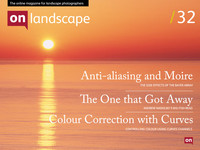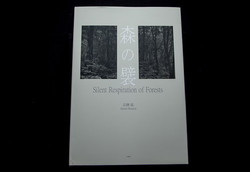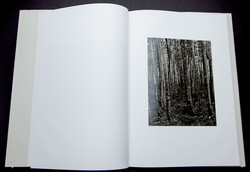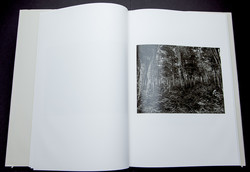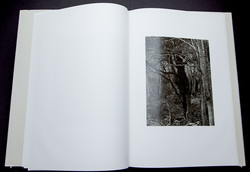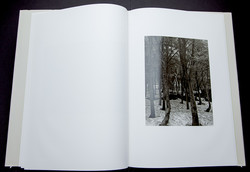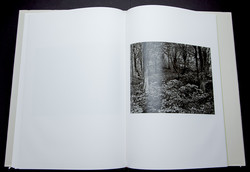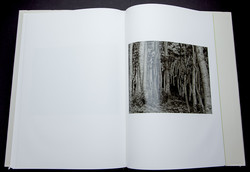Book reviews

Tim Parkin
Amateur Photographer who plays with big cameras and film when in between digital photographs.
Olaf Otto Becker - Broken Line
We’ve reviewed Olaf’s ‘Above Zero’ in a previous issue and we were equally enamoured of it’s aesthetic sensibilities with its depth of seeing and the story it carried. We contacted Neil McIlwraith at Beyond Words to ask about other books and he recommended we take a look at ‘Broken Line’. From first opening, we knew we were unlikely to be disappointed. The tipped in picture on the front cover and the embossing of the Greenland coastline on the pale blue cloth cover all pointed to an attention to detail that is carried on throughout.
This book documents a journey (or, possibly more appropriately, a broken journey) that Olaf took between 2003 and 2006. He decided to take his 8x10 camera from one end of the Greenland coastline to the other, a task made slightly more difficult because it has no roads at all and travelling by boat is extremely dangerous. The photographs were mostly taken in the summer months, when it is always light, and shot in the middle of the night when twilight lends the landscape an otherworldly look.
But more than these aesthetic considerations, it is the documentary nature of each photograph that suggests the transient that is particularly interesting. Each image has a GPS location and time associated with it - each picture pinpointed in both time and space. This message is that of impermanence. Even the photographs of the occasional habitation look transitory, houses perched on a bare rock, possessions scattered on surfaces. The overall feel of the book is of a document of change, transient beauty with the occasional human punctuation.
These aren’t all political statements though, Olaf allows the viewer and the essays to make these statements. The pictures can stand on their own as beautiful, formal compositions using exquisite light and each taken with an obvious attachment to the subject matter. From the mist wreathed icebergs of the introduction, through the bare, ice ground rocks and rugged cliffs to the occasional settlement - all the more shocking for the mess surrounding them and the detachment from the beauty of their surroundings (even the the point of hanging pictures of Nordic kitsch on the only interior wall shown).
The whole work is a study in how romantic photography can integrate with a fine art approach to create a work of beauty that can also act as both a documentary and philosophical work. A book that can work on multiple levels and one that I enjoyed immensely.
You can buy ‘Broken Line’ from the Beyond Words website.
Takeshi Shikama - The Silent Respiration of Forests
I had seen Takeshi Shikama’s ‘Silent Respiration..’ series before on a couple of websites and was very impressed with the beauty of his platinum-palladium prints of exquisite forest and flora subject matter. I was hoping that this book would be more of this work but was disappointed to find that it the subject matter was more homogenous and consisted of a set of silver prints, not the platinum prints I had seen. This is not to say the photographs were poor but they did not excite me in the same was as the material I had seen originally. The book is also difficult to browse with a tight binding that doesn’t lay flat without a lot of pressure. Overall a little disappointed. If you want to see the work I would like to see made into a book - take a look here (http://www.klotzgallery.com/?page_id=2576).
Sean Scully - Walls of Aran / Mariana Cook - Stone Walls
I’ve had in the back of my mind for some time the idea of creating a body of work based around stone walls but always had in the back of my head that somebody must have done this before. Whilst browsing around Amazon recently I saw two books about the subject matter that reminded me of these thoughts. The first, “Walls of Arran” by Sean Scully looks more my cup of tea - working with a limited subject matter and location, the opportunity for self expression was there and with a publisher such as Thomas and Hudson. Sadly this book turned out to be more of a poor typology of walls - seemingly poorly reproduced at varying levels of (sometimes inappropriate) enlargement. I tried to spend time with the book to discover something beyond straight reproductions, something that would reveal itself in the patterns and rhythm of the pictures. Alas, no.
However, the book I purchased that I was unsure about, Marianne Cook’s “Stone Walls” turned out to be the book I was looking for. Its cover had what looked like another Aran stone wall (albeit well produced) but I shouldn’t have worried. Mariana has travelled around the world from her home in Massachusets to places as far afield as Ireland, Mediterranean, Peru, Britain and the US.
The book is divided into three main chapters, Personal Boundaries, Containment and Back to Earth plus a series of essays on each location by Wendell Berry. Personal Boundaries shows the walls from a distance, Containment from close up, details and fine structure and Back to Earth shows the decay of stone walls.
The images are uniformly good but many are beautiful. All simple, square black and white images with very little obvious treatment. I later found out that Mariana Cook was one of Ansel Adam’s last protege and this shows in the balance and poise of the compositions. The photographs of the White Peak in the Peak District recall Paul Hill’s work and at times an echo of Goldsworthy appears (a well known natural landscape artist but lesser known photographer).
The book is the antithesis to Sean Scully's, this is about photography in its role as narrative and art. The pictures show the similarities and differences between human constructs, from ramshackle make, do walls as purely functional barriers to the perfection of the South American constructs and the beauty of the British enclosures (interestingly, Mariana chose to photograph a Goldsworthy wall
Gus Wylie - Hebridean Light
Gus Wylie is a photographer I knew very little about. The name rang a few bells from snippets in the popular photography press and I had seen his book on the shelves of a tourist centre in Lewis on my own trip to the Hebrides in 2005 so this book was an introduction for me. The book itself isn’t what you would really call a landscape photography book, it is more in the genre of the photo essay and it is its narrative that attracts. We aren’t looking at a photographer who has spent his time perspiring over the minutiae of formal composition or that works producing perfect prints, Gus seems to use the camera as a tool in the vein of Lartigue's ‘eye-trap’, an extension of his vision, recording moments of his experiences to create a very personal record of the Hebrides. Much of the content is documentary in nature, sheep shearing, tweed production, pictures of families outside their homes, seaweed gathering, etc. but it’s the occasional gem such as the play of the fish scales and wet sand ripples or abandoned church window, thistle and shaft of light opposite a carved gravestone. If you are just after landscape photography, this book probably won’t interest you too much but if you want a slice of what the Hebrides is about and an example of a great photo essay it’s well worth a look.

